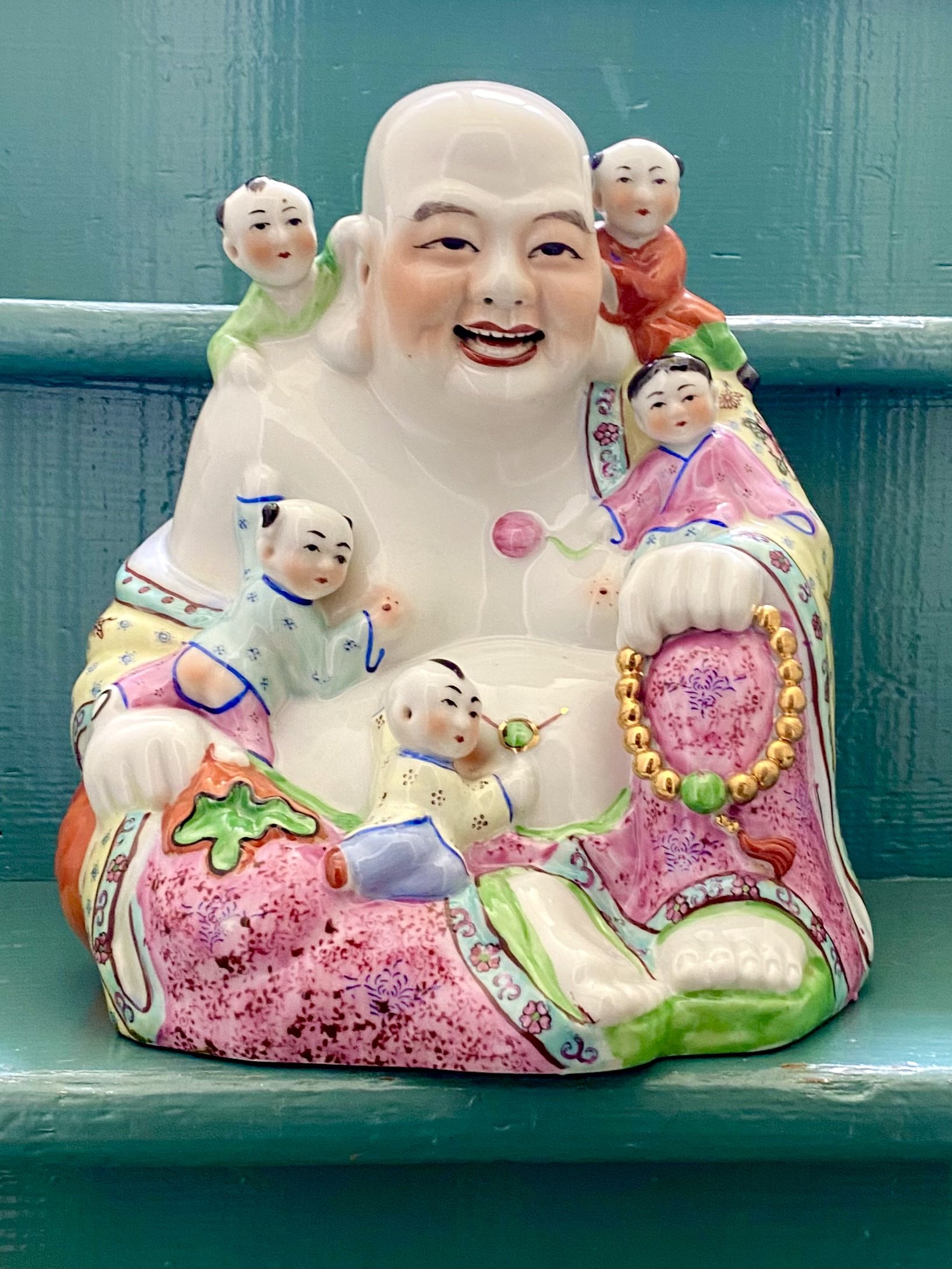 Image 1 of 2
Image 1 of 2

 Image 2 of 2
Image 2 of 2



Laughing Buddha
Have we ever mentioned how much we LOVE Chinese kitsch? It's so joyful and exuberant. Compare (for example) this charming Buddha, created for a home or shop altar, to the crucified Christ or dour saints of popular Christian iconography. This is Budai, the “Laughing Buddha,” a rotund, jolly figure, usually depicted carrying a large sack, with one or more children trailing behind him. He is based on the actual, historical figure Qici, a wandering monk who lived in the Wutye kingdom (roughly the region of modern Zhejiang and Shanghai) in the 10th century. He was an eccentric fellow for a Buddhist monk, wandering at will, eating and drinking, and enjoying life with Dionysian flair.
Despite his unorthodox ways, Budai has had an outsize influence on popular Buddhism. Partly this is due to syncretism, in which older, local gods were enfolded into the Buddhist pantheon. He is immensely popular in China, where he represents contentment, abundance, and forgiveness, among other things. He is so popular in fact that many people think the fat, laughing Buddha is the original Buddha, Siddhartha Gautama.
Not quite, but… Buddhist tradition holds that sometime in the future (perhaps millions of years from now) the next Buddha, Maitreya (the fifth and final Buddha of the current age) will me incarnated, ushering in a golden age of enlightenment. In the meantime, it is thought that Maitreya sends forth "emanation bodies" to teach the Dharma and help the people deal. Chan (Zen) Buddhist tradition holds that Budai/Hotei is one of these, essentially a manifestation of Maitreya on earth. Many have claimed to be the next Buddha (or have had that claim made for them), which has caused a lot of drama, and schisms. But Hotei gets my vote! He keeps it light enough to travel.
Have we ever mentioned how much we LOVE Chinese kitsch? It's so joyful and exuberant. Compare (for example) this charming Buddha, created for a home or shop altar, to the crucified Christ or dour saints of popular Christian iconography. This is Budai, the “Laughing Buddha,” a rotund, jolly figure, usually depicted carrying a large sack, with one or more children trailing behind him. He is based on the actual, historical figure Qici, a wandering monk who lived in the Wutye kingdom (roughly the region of modern Zhejiang and Shanghai) in the 10th century. He was an eccentric fellow for a Buddhist monk, wandering at will, eating and drinking, and enjoying life with Dionysian flair.
Despite his unorthodox ways, Budai has had an outsize influence on popular Buddhism. Partly this is due to syncretism, in which older, local gods were enfolded into the Buddhist pantheon. He is immensely popular in China, where he represents contentment, abundance, and forgiveness, among other things. He is so popular in fact that many people think the fat, laughing Buddha is the original Buddha, Siddhartha Gautama.
Not quite, but… Buddhist tradition holds that sometime in the future (perhaps millions of years from now) the next Buddha, Maitreya (the fifth and final Buddha of the current age) will me incarnated, ushering in a golden age of enlightenment. In the meantime, it is thought that Maitreya sends forth "emanation bodies" to teach the Dharma and help the people deal. Chan (Zen) Buddhist tradition holds that Budai/Hotei is one of these, essentially a manifestation of Maitreya on earth. Many have claimed to be the next Buddha (or have had that claim made for them), which has caused a lot of drama, and schisms. But Hotei gets my vote! He keeps it light enough to travel.
Have we ever mentioned how much we LOVE Chinese kitsch? It's so joyful and exuberant. Compare (for example) this charming Buddha, created for a home or shop altar, to the crucified Christ or dour saints of popular Christian iconography. This is Budai, the “Laughing Buddha,” a rotund, jolly figure, usually depicted carrying a large sack, with one or more children trailing behind him. He is based on the actual, historical figure Qici, a wandering monk who lived in the Wutye kingdom (roughly the region of modern Zhejiang and Shanghai) in the 10th century. He was an eccentric fellow for a Buddhist monk, wandering at will, eating and drinking, and enjoying life with Dionysian flair.
Despite his unorthodox ways, Budai has had an outsize influence on popular Buddhism. Partly this is due to syncretism, in which older, local gods were enfolded into the Buddhist pantheon. He is immensely popular in China, where he represents contentment, abundance, and forgiveness, among other things. He is so popular in fact that many people think the fat, laughing Buddha is the original Buddha, Siddhartha Gautama.
Not quite, but… Buddhist tradition holds that sometime in the future (perhaps millions of years from now) the next Buddha, Maitreya (the fifth and final Buddha of the current age) will me incarnated, ushering in a golden age of enlightenment. In the meantime, it is thought that Maitreya sends forth "emanation bodies" to teach the Dharma and help the people deal. Chan (Zen) Buddhist tradition holds that Budai/Hotei is one of these, essentially a manifestation of Maitreya on earth. Many have claimed to be the next Buddha (or have had that claim made for them), which has caused a lot of drama, and schisms. But Hotei gets my vote! He keeps it light enough to travel.